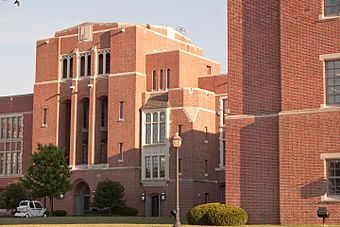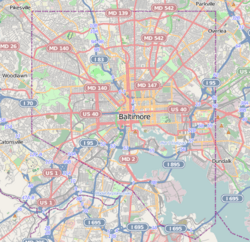Eastern High School (Maryland) facts for kids
Quick facts for kids |
|
|
Eastern High School
|
|

old Eastern High School, 33rd Street and Loch Raven Boulevard, August 2011
|
|
| Location | 1101 East 33rd Street at Loch Raven Boulevard Baltimore, Maryland, 21218, U.S.A. |
|---|---|
| Area | 17 acres (6.9 ha) |
| Built | 1936—1938 |
| Architect | James Edmunds Herbert Crisp |
| Architectural style | Tudor Revival & Jacobethan |
| NRHP reference No. | 00000870 |
| Added to NRHP | August 16, 2000 |
Eastern High School opened in 1844. It was a public high school just for girls in Baltimore, Maryland. It had a sister school called Western High School.
The school's last building is at 1101 East 33rd Street. It is near The Baltimore City College. It is also across from the old Memorial Stadium. The Baltimore City Public Schools system ran Eastern High School. It closed in 1986.
The final building was fixed up in the 1990s. Now, Johns Hopkins Medical Institutions use it for offices. The building became a recognized historic place in 2000. It is on the National Register of Historic Places.
Contents
History of Eastern High School
In 1839, Baltimore City started its first public high school. It was called City College. Public schools for white boys and girls had been open since 1829. But girls could not go past elementary school until 1844.
The Baltimore Board of Education wanted girls to have more chances. They said girls with "superior abilities" should get a higher education. However, for many years, girls could not study languages or advanced science and math. Black children in Baltimore could not go to public schools until 1867.
Starting Two Girls' Schools
People thought girls were too delicate to travel across the city. So, two schools for girls were created. They were named Eastern and Western High Schools. Their names came from their location near the Jones Falls.
To attend Eastern, a girl had to be at least 12 years old. She also needed to have spent one year in a primary school for girls. She had to have good character and pass an entrance test. There was a small fee of $1.00 every three months. But students could get a waiver if they could not pay.
Changes Over the Years
Girls first attended Eastern for three years. In 1867, this changed to four years. More changes came in 1898. Students could then choose some subjects. This meant they could focus on certain areas of study. They did not have to study every subject in detail for all four years.
By 1920, the school had its own colors: green and gold. It also had a school flag and a school song. In 1924, Laura J. Cairnes became the first female high school principal in Baltimore. She led Eastern High School.
World War II Efforts
During World War II, students at Eastern helped raise money. They sold war bonds and stamps. From December 1941 to June 1943, they raised over $200,000. This was a lot of money at that time.
Integration and Protests
In September 1954, Baltimore schools became integrated. This happened after the Brown v. Board of Education decision. For the first time, African-American girls could attend Eastern High School.
On February 20, 1970, students protested. They were upset about a teacher's words. Police were called to the school. By 1984, most students at the school were African-American.
Becoming Coeducational and Closing
In 1979, Eastern High School began to accept boys. It also added a business magnet program. This program offered special classes. The school also started limiting who could attend. Students had to meet certain requirements.
Despite these changes, Eastern High School was nearing its end. In 1984, the Baltimore City Public Schools wanted to close some schools. They said Eastern had low test scores and low student numbers. They also said the building needed expensive repairs.
Some people believed the school was closing for other reasons. They thought it was to make more parking for Memorial Stadium. A large part of the school's lawn had already been taken for parking. Supporters tried to keep the school open, but their appeal was rejected.
In June 1986, Eastern High School closed for good. Many students and the business program moved to Lake Clifton. This school was once the largest public high school in America. Lake Clifton-Eastern later closed in 2003. However, its building is still used by another school.
Eastern High School Locations
Eastern High School moved several times during its 142 years. This happened as more students enrolled or as buildings got too old.
- From November 1844 to July 1852: Front and Pitt (now Fayette) Streets
- From September 1852 to August 1868: Aisquith and Mullikin Streets
- From August 1868 to August 1870: Baltimore and Lloyd Streets
- From September 1870 to December 1906: Aisquith and Orleans Streets. This building was in the Greek Revival style.
- From January 1907 to February 1938: Broadway and North Avenue
- From February 1938 to June 1986: East 33rd Street and Loch Raven Boulevard
The last building was a three-story, "H"-shaped structure. It had a main section and four wings. James R. Edmunds, Jr. and Herbert G. Crisp designed it. They also designed the new Western High School building. The campus was known for its design and large, shady yard.
The building has a strong frame of steel and concrete. It is covered with red brick and carved limestone. Its style is Tudor Revival or Jacobethan. After closing in 1986, the building was renovated in the 1990s. It is now a historic landmark. Johns Hopkins Medical Institutions use it for offices. The building was listed on the National Register of Historic Places in 2000.
The Good Shepherd Statue
After Eastern High School alumna Lizette Woodworth Reese died in 1935, her friend Grace Turnbull created a memorial. It was a statue called "The Good Shepherd." It shows a shepherd holding a lamb with his flock behind him. It was placed on the school grounds in 1939. Even after Eastern closed, the statue stayed in its original spot.
Notable People from Eastern High School
Many talented people attended or worked at Eastern High School.
- Virginia S. Baker: She was a civil servant. A recreation center is named after her.
- Laura J. Cairnes: She became the first woman principal of Eastern High School in 1924.
- Vashti Murphy McKenzie: She was the first woman bishop in the African Methodist Episcopal Church.
- Elsie Shutt: She was the first woman to start a software business in the United States.
- Lizette Woodworth Reese: She was a poet and later an English teacher at Western High School.
- Rose Zetzer: She was the first woman allowed to join the Maryland State Bar Association.


